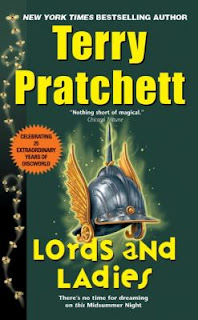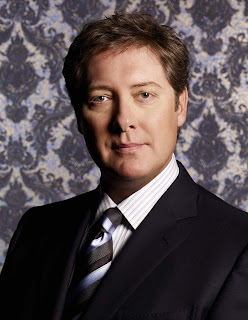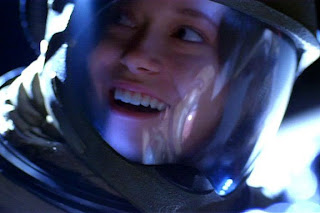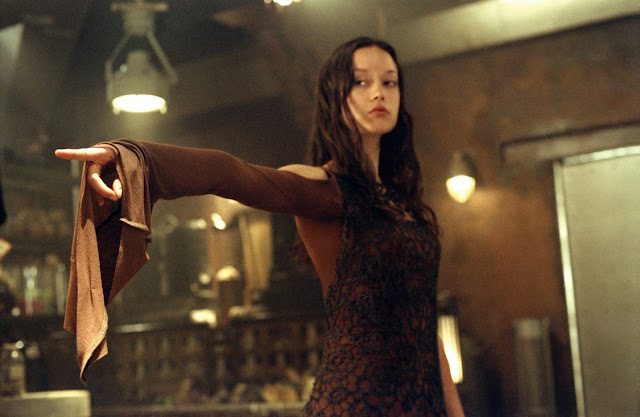It’s time once again, my dear readers, to stop and
appreciate the sheer genius that is Terry Pratchett’s Discworld. Not only are
the books well-written, funny, and carefully plotted, they also contain complex
characters, biting social commentary, and footnotes. Truly, they are a gift.
I know I said that in my pompous voice, but I really do mean
it. Like I said about Monstrous Regiment
and Maskerade, Terry Pratchett is a
really fantastic author. And, he’s the rare male fantasy writer that can
actually come up with a convincing female character. Doubt me? Well then let’s
just take a look at some of his finest female characters: the Witches.
For those of you who aren’t actually into the Discworld
books, first off, shame on you, and second, here’s the scoop. The Discworld
series is a bunch of loosely interconnected stories that all take place in the
same (insane) world: the Discworld. It’s a disc, lying on the back of four giant
elephants, which are standing on the back of A’Tuin, the great World Turtle.
So, fantasy.
But clever fantasy. While the world is ostensibly a fantasy
realm of the swords and sorcerors mode, the stories range from the discovery of
guns to an analysis of the postal service to religious treatises to a crazy
person trying to murder Santa. Or rather, the Hogfather. Everything is thinly
veiled representation of our world, done up with some impeccable wit and a
solid dose of common sense. I wasn’t kidding before. You should totally read
whatever part of this series you can get your hands on. There are about forty
books in all. It shouldn’t be hard to find one.
In particular, though, I want to look Lords and Ladies, one of his middle-era books that features the Witches.
The book itself is pretty good. Not one of his best, but he doesn’t really have
any bad books, and with so many, it’s only statistics that some of them will
fall to the middle. Besides, Terry Pratchett’s “okay” is another man’s
“lifetime best”. So there’s that.
Lords and Ladies
is the third book in the Witches trilogy, and follows the intense misadventures
that happen when the three witches come back from abroad just in time for
Magrat, the youngest, to get married to the newly crowned King of Lancre,
Verence. Magrat and Verence fell in love in the earlier book Wyrd Sisters, and now they’re getting
married. That’s nice.
Except for the bit where it isn’t, because if Magrat is
going to be Queen of Lancre, then she can’t also be a witch, and besides, she’s
not going to qualify as the Maiden anymore, is she? (Though there is a running
joke in the book that she very well might, as neither she nor Verence has much
family to explain things to them, and they’re both a little, well, nice.)
Anyway, Granny Weatherwax and Nanny Ogg, the Crone and
Mother, respectively, are at a bit of a loss with what to do now. It seems that
they should train up someone new to replace Magrat, but who to train? Oh, and
someone seems to have been dancing around the Stones up on the hill, and that
can’t be a good thing, since those stones were put there to keep something out,
and dancing is just the sort of thing that might let it back in.
That something is elves, and the dancing does indeed let the
elves back through. As we’re painstakingly shown, these aren’t nice
Tolkien-esque elves. These are the terrifying elves of Celtic mythology, who
don’t give two craps about the lives of mortals, and really just like to watch
us squirm before they eat us. In two shakes the elves have poor Verence under a
spell and in their clutches, Granny Weatherwax on the ropes, the citizens of
Lancre terrified out of their wits, and Magrat…well, we’ll get to Magrat.
Like with everything he does, Terry Pratchett starts out his
characters for the Witches with easy stereotypes. You have three witches, so
obviously you have a Maiden, a Mother and a Crone. They fit their types
perfectly, as well they should.
But.
Just because they fit their types so incredibly well doesn’t
mean they aren’t also complex and interesting characters. That’s what’s so
special about Pratchett. He doesn’t just take the easy road. He takes the easy
road and makes it the fricking hard one.
We’ll start with Granny Weatherwax, since she is, arguably,
the easiest one to figure.
Granny, whose real first name is Esmerelda, but no one’s
called her that in years, is a Witch’s Witch. She likes wearing black,
scowling, and sending her mind out to run around the forest in the body of a
deer or a rabbit or a crow. She’s not particularly nice, but she is good, and
she’s quite content to tend to her bit of earth and stare anything that don’t
belong there into submission. She’s also not so hot on grammar.
But Granny, despite all initial appearances, is quite
complex too. She isn’t just this all knowing, all powerful force to be reckoned
with. I mean, she is a force to be reckoned with, but she’s a force that has
its moments. It’s moments of doubt, I mean.
And that’s kind of a big deal. Because we’re all up on the
idea of the Witch who’s basically invincible, a sort of wise older woman with
no time for nonsense and an iron spine. My high school German teacher,
basically. It’s easy for us to imagine Granny this way. But it’s also wrong.
The brilliance of what Pratchett does is he takes this very
simple character, one who we like to think of as unshakable, and shakes her. We
see her limits, and we realize that there’s a lot more to being an unshakable
old lady in a black dress than we think at first glance.
There’s also Nanny Ogg here too. Nanny’s the Mother, and she
certainly fits the bill. The books never specify about how many children or
husbands Nanny has had, since it establishes that she’s a bit shaky on both.
Either way, she’s mother, or, perhaps more accurately, she a mum. Nanny, whose
first name is actually Gytha, but only Granny Weatherwax uses that, is a
drunken, lecherous, bawdy old lady. And yet, she makes perfect sense.
I mean, who would be a mother witch? You think immediately
of someone sensible and clean and tidy, who likes cooking and gently nurtures
all those around her. But really, is that actually what a mother, someone who
mothers the whole country, would be like?
Heck no! Of course she’s bawdy and lecherous. She’s had who
knows how many children – obviously she knows how things work down there. And
naturally she’s a bit odd – she has fourteen kajillion children and
grandchildren. She’s besotted with her grandkids, never cleans if she doesn’t
have to, makes her daughter-in-laws lives hell, and treats all her sons like
they’re five, because of course she does.
That’s what I mean about the character development in these books. Pratchett
took the easy path, of making the Mother really and truly a mother, then made
it harder by making her the most mothering mother to ever mother.
And finally, we’ve got Magrat Garlick, the Maiden. I’ll be
totally honest and admit that while Magrat gets pooped on the most of all the
characters, she’s probably the one I relate to most easily, for one simple
reason: Magrat really and truly believes that the world is a good place and
that the people in it are nice and kind. And nothing ever seems to manage to
dissuade her of that notion.
So as the Maiden, it’s obvious that Magrat can’t have had
sex, but Pratchett, like with so may other things, took it much further than
that. Magrat isn’t just a virgin sexually, she’s basically a virgin mentally
too. She believes in things, lots of things, like the importance of hygiene and
the power of fairies and having a holistic understanding of witchcraft. She’s
nice. She’s impractical and gets in her own way a lot. She’s grossly
inexperienced and that’s what makes her great.
This book, for all that it purports to be an ensemble
adventure, is really Magrat’s book. It’s about her wedding to King Verence, her
incredibly skill at getting in her own way, and the realization that she comes
to at the end. Well, she comes to a couple of realizations, but they’re all
good.
Magrat comes to see that if she wants to be a queen, which
she doesn’t really, but she also doesn’t want anyone else to do it either, then
she has to actually be the queen. She
has to step up and fight for her man. She has to strip herself down to the core
of her identity and figure out who she is. As it turns out? Magrat is kind of a
badass.
There’s a line in the book that really resonated with me,
because it’s so ridiculously obvious that it’s never occurred to me before
(Pratchett does that a lot, for the record). “The price for being the best is
that you have to be the best.”
That’s it. It’s so simple and yet so hard, and it relates to
fricking everything.
If Magrat wants to be the queen, then she has to actually be the queen. If you want to write
complex, interesting female characters, then write, complex interesting female characters. That’s literally all
there is to it.
I love Terry Pratchett. If his books were all just a giant
parade of male protagonists and masculine plots I’d probably still love him
because they’re that good. But they aren’t. They have female characters,
complex female characters, and stories that aren’t about teenage girls learning
how to be teenage girls, but about witches learning how to be queens and then learning
how to be queens. About female
villains and female heroes and female witches and – you get the point.
The point is that I just want to stop for a second and
appreciate the Witches. Appreciate what Mr. Pratchett did in writing them, and
appreciate the fact that now we have these characters. These characters who
aren’t simple, who aren’t easy, and who definitely are not lowest common
denominator, but who still manage to be universal. And that he did it because
he could do it.




















